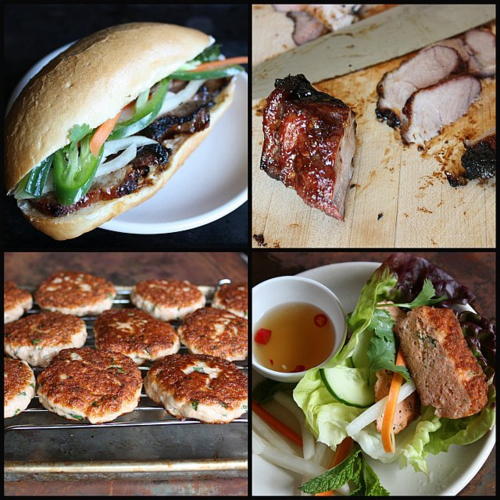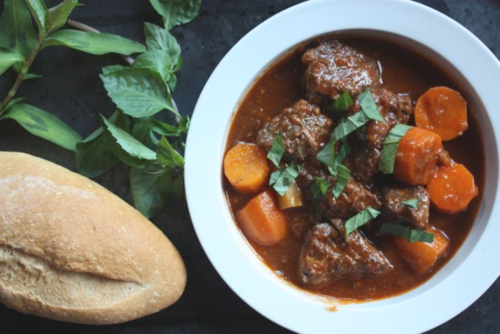Linda wrote to me over the weekend via the VWK Facebook page. She posed a question that I hadn’t considered:
I'm hoping you can suggest some Vietnamese dishes that freeze well. I am having a baby in a little over a week and would love to stock the freezer with some comforts of "home". 🙂
While I do know about freezing food and Vietnamese cooking, I know next to nothing about pregnancy and babies. My husband and I do not have children. To seek an answer for Linda, I sought advice from someone with lots of experience in the matter: My mother. She had five kids through war time and peace time in Vietnam. She’s lived in America for decades and loves to freeze food. That’s how she manages to put on lavish meals for crowds of people.
Here’s what mom said:
You can freeze practically anything so long as there are no ingredients that can get water logged. For example, pork in caramel sauce with boiled eggs [thit heo kho trung] does not freeze well because the whites get chewy and watery from freezing. If you avoid things like that, you realize you can freeze many dishes.
Don’t you remember how I packed things for your sisters when they went to college? Every time they came home or when we went to USC to visit them, we packed food. I made their favorites, divided it up into small plastic containers, and froze them. Then they returned the empty containers for me to refill in the future. You can freeze most things, just not ones with watery ingredients.
Not knowing what Viet foods a woman may crave after giving birth, I threw out some suggestions to my mom, who approved of the following:
Beef stewed with tomato, carrot and star anise (Bo kho, Into the Vietnamese Kitchen, page 151) -- Make the stew but don’t add the carrots in step 5. Remove from the heat , cool, then freeze the beef and sauce. Thaw and add the carrots to the stew if you think the beef needs to cook for 20 to 30 minutes to become fully tender. If the meat is already tender, parboil the carrots for 5 to 8 minutes, then add to the heating stew; let things simmer for 5 to 10 minutes to finish cooking the carrot and allow flavors to meld.
Chicken, lemongrass and potato curry (ca-ri ga, IVK, page 83) – Simmer the chicken and cut the cooking time by not adding the potato in step 3. The chicken becomes tender during cooling. Freeze the chicken and sauce. Thaw and reheat the chicken and sauce. Meanwhile, parboil the potato for 5 minutes then add to the chicken and sauce to finish cooking the potato and meld flavors.
Chicken and ginger in caramel sauce (ga kho gung, IVK, page 82) – After cooking the dish (step 2), cool then freeze. The color after thawing will be dark brown instead of a handsome reddish brown but the flavor will be nice. Taste and if it is too salty, add a splash of water to soften the flavor. Garnish with the scallion to perk up the presentation.
Pork riblets in caramel sauce (suon kho, IVK, page 148) – Remove from the heat after simmering for 45 minutes in step 3. Cool and refrigerate. Remove the fat on top, then freeze the riblets and sauce. Thaw and taste the sauce. Reheat and simmer, until the ribs are tender and the sauce intensely savory tasting.
Chinese barbecue pork (thit xa xiu, char siu pork, IVK page 142 or Banh Mi Handbook, page 89) – Just cook then cool and freeze the pork as uncut pieces. A smidgen of the flavor is diminished from freezing, which is why I didn’t mention freezing in the banh mi book. Thaw then reheat the pork in an oven or toaster oven; mix up a half batch of the marinade to brush on the pork during baking to refresh. I suppose you could freeze these lemongrass pork steaks too.

Herbed salmon cakes (cha ca, BMH, page 79) – Follow the freezing and reheating instructions in the recipe “Note.” These are fabulous and a fast fix for banh mi (sandwich or lettuce wrap) or to eat with rice or instant noodle soup.
So are there things that Vietnamese women eat or don’t eat after giving birth? I asked my mom. She hesitated and then responded:
In Vietnam, they said that after giving birth, women should avoid sour food but I never figured out why. Some people like to simmer pork shank with banana stem, supposedly to help lactation. One idea for doing is that is because the juice from the banana stem is suppose to be good for you, but I was not quite sure about that.
Women recovering from childbirth were often fed foods that were cooked down and salted. That made me feel really heavy and uncomfortable. When your aunt and I both got to give birth at Saint Paul Hospital in Saigon, the nuns there fed us western style foods. They gave us huge plates full of chayote cooked with just a little fat and simply prepared meats. I loved that. All the vegetables were great.
Tell this young woman to eat what she feels will make her feel better. That is most important. She should not to worry too much.
That’s solid advice from a woman who has been around. If you have post-childbirth foods to suggest or experiences to share, now’s the time to do it.
A few tidbits and notes:
- As for that banana stem business, I think my mom was speaking about health benefits described in this post on Ayurvedic benefits of eating banana stem/trunk or drinking its juice. It supposedly helps weight reduction, which I imagine a woman looks forward to after giving birth.
- I’ve seen bags of mysterious wild herbs at Hmong markets that are for postpartum chicken soup. A male friend introduced me to it. “You don’t have to be pregnant to enjoy it,” he told me. I bought a bag, cooked it up and realized he was totally correct. Tasty postpartum Hmong chicken soup.
- An 2013 LA Times story on yuezi, a Chinese 30-day diet for women recovering from childbirth.




















